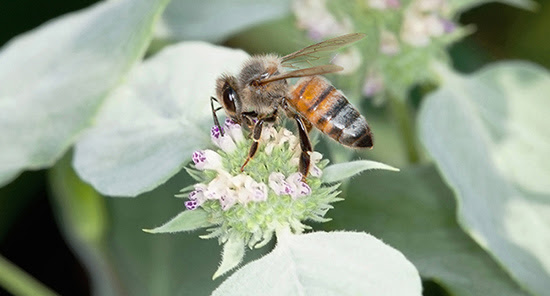Jun 23, 2021Four nutrients in flower pollens improve honeybee gut health
For the first time, four nutritional compounds found in different flowers have been directly proven to enhance gut health of honeybees, boosting their immune system and increasing lifespan, based on a study by U.S. Department of Agriculture’s Agricultural Research Service scientists.
“We found that feeding caffeine, kaempferol, p-coumaric acid or gallic acid – all nutritional compounds found in the nectar and pollen of various flowers –improved the abundance and diversity of bacteria in the honeybees’ gut,” explained entomologist Arathi Seshadri. She is with the ARS Invasive Species and Pollinator Health Research Unit in Davis, California.
Seshadri chose these four nutrients to test because they are naturally present in flowers favored by honeybees, and they had already been shown to improve honey bee lifespan and tolerance to a common pathogen, Nosema ceranae. Caffeine, for instance, also has been shown by researchers to make bees better learners and improve their memory of rewarding floral scent and nectar quality. This study is the next step in more specifically defining how some nutrients in flower pollen can help bees by showing a connection through improving the gut microbiome.
The gut microbiome is the total amount and species of all the microorganisms and all of their collective genetic material present in the gut.
“The beneficial impact of these nutrients, found in a wide variety of flowers, has implications for healthier hive management through designing better dietary supplements. It also reemphasizes the need for flowering habitats that can provide bees with access to a rich diversity of pollen and nectar sources,” Seshadri said.
While the mechanism is not known for how these four nutrients enhance honeybees’ gut microbiome, p-coumaric acid has been suggested by other researchers to alter gut microbiome diversity by increasing the activity of honeybees’ immunity genes. This perturbs the growth of pathogens acquired while foraging.
Example flower sources for these nutrients include: caffeine: citrus and coffee; gallic acid: mint, raspberry, sunflowers and apples; kaempferol: petunias, asters, canola and poppies; and p-coumaric acid: buckwheat, roses, and clover.
While caffeine had the single greatest impact, all the four nutrients resulted in the increase in abundance of Commensalibacter, Snodgrassella and Bombella bacteria, all of which are considered important core bacteria for a healthy honeybee gut.
Changes in the honeybees’ microbiome were seen immediately, just three days after they received the supplements.
The growth spurt in the gut microbiome reached a plateau by six days after supplementing the diet with each of the floral nutrients and the levels reset to the original baseline levels when supplements were discontinued.
“This fast response shows how much of an impact manipulating honeybees’ diet may have on their microbiome and reiterates the need for diverse flowering plants that can provide bees with ready access to these nutrients,” Seshadri said.
The study was published in the Journal of Applied Microbiology.
The Agricultural Research Service is the U.S. Department of Agriculture’s chief scientific in-house research agency. Daily, ARS focuses on solutions to agricultural problems affecting America. Each dollar invested in agricultural research results in $17 of economic impact.
– Kim Kaplan, USDA















